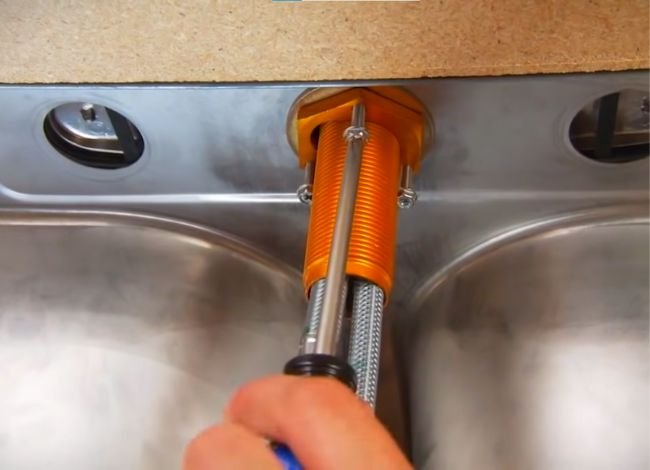A single-handle kitchen faucet is a type of faucet that has a single lever or handle that controls both the temperature and flow of water. The handle is usually mounted on top of the faucet or on the side and can be easily rotated to adjust the water temperature and flow rate. Single-handle faucets are a popular choice for many homeowners because they are easy to use and can save space in the kitchen. They are also often more affordable than double-handle faucets.
Install a single-handle kitchen faucet with a sprayer
Installing a single-handle kitchen faucet with a sprayer is a relatively simple process that most homeowners can do themselves. Here are the steps to follow:
- Turn off the water supply to the faucet by shutting off the valves under the sink. Then remove the old faucet.
- Install the base plate or mounting plate for the new faucet, if necessary. This plate will cover the holes in the sink and provide a surface for the faucet to mount to.
- Place the new faucet onto the sink, aligning the mounting holes with the holes in the sink or base plate.
- Secure the faucet to the sink using the mounting nuts and washers that came with the faucet. Tighten these nuts as much as you can by hand, then use a basin wrench or adjustable pliers to finish tightening them.
- Attach the hot and cold water supply lines to the faucet using the mounting hardware and gaskets that came with the faucet.
- Install the sprayer, if included, by attaching the hose to the faucet and securing it with the coupling or other connection provided.
- Turn the water supply back on and test the faucet and sprayer to make sure they are working properly.
- Install any decorative caps or handles that came with the faucet, if desired.
Single or double-handle kitchen faucet?
Both single-handle and double-handle kitchen faucets have their own advantages and disadvantages. Here are some of the main differences between the two:
Single handle faucets:
- Easy to use
With a single handle, you only need to worry about adjusting one lever to control the temperature and flow of water. This can be especially convenient when you have dirty hands or are trying to multitask in the kitchen.
- Save space
Because they only have one handle, single handle faucets take up less space on the sink or countertop. This can be a major advantage if you have a small kitchen or limited counter space.
- More affordable
Single handle faucets are often more affordable than double handle faucets, especially when you consider the cost of the extra handle and the additional mounting hardware and plumbing parts that are required.
Double handle faucets:
- More precise temperature control
With separate handles for hot and cold water, double handle faucets allow you to fine-tune the water temperature more precisely than a single handle faucet. This can be especially important if you have young children or elderly family members who are sensitive to extreme water temperatures.
- More traditional look
Double handle faucets are often associated with a more traditional or classic look, which some homeowners may prefer.
- Durable
Because they have two handles and are often made with higher-quality materials, double-handle faucets may be more durable and long-lasting than single-handle faucets.
Frequently Asked Questions
Q: Do I need any special tools to install a single handle kitchen faucet with a sprayer?
A: Typically, you’ll need adjustable wrenches, pliers, a basin wrench, and plumber’s tape. Check the manufacturer’s instructions for any specific tools required for your faucet model.
Q: How do I remove my old kitchen faucet?
A: Turn off the water supply, disconnect the water lines, and use a basin wrench to remove the nuts holding the faucet in place. Carefully lift out the old faucet.
Q: Can I install a new faucet without altering the sink?
A: Yes, most single handle faucets are designed to fit standard sink configurations. Ensure your new faucet matches the hole pattern of your sink.
Q: How do I connect the sprayer to the faucet?
A: The sprayer typically connects to a designated port on the faucet body. Follow the manufacturer’s instructions for secure attachment.
Q: What’s the best way to ensure a watertight seal?
A: Apply plumber’s tape to the threads of connections and ensure all fittings are tightened securely but not overtightened.
Q: How do I deal with low water pressure after installation?
A: Check for any kinks in the lines or debris in the aerator. Ensure all valves are fully open.
Q: Is it normal for the faucet to drip briefly after use?
A: A brief drip after shutting off is normal due to residual water in the spout, but continuous dripping indicates a potential leak or issue with the internal mechanism.
Q: Can I install a filter on this type of faucet?
A: Yes, most filters can be attached to the faucet’s aerator thread. Ensure compatibility with your faucet model.
Q: How often should I clean the aerator?
A: Clean the aerator every 3-6 months to remove mineral build-up and maintain proper water flow.
Q: What should I do if the sprayer hose is too short?
A: You may need to purchase an extension hose compatible with your faucet model.
Q: How can I prevent the faucet from becoming loose over time?
A: Regularly check and tighten the mounting nuts. Avoid excessive force when operating the faucet.
Q: What’s the best way to clean and maintain the faucet’s finish?
A: Use a mild soap and water solution, avoiding harsh chemicals and abrasive materials. Dry with a soft cloth to prevent water spots.




